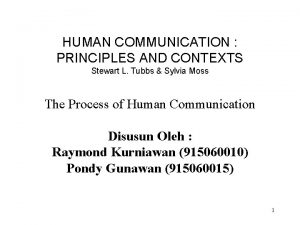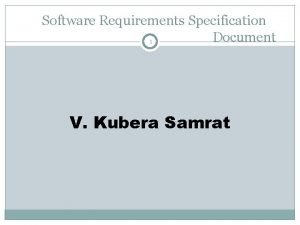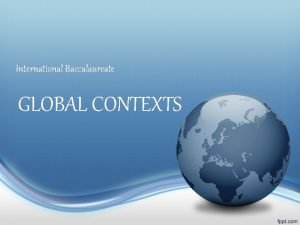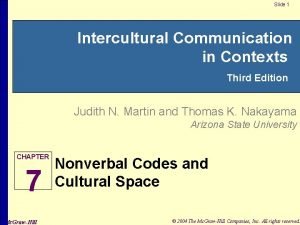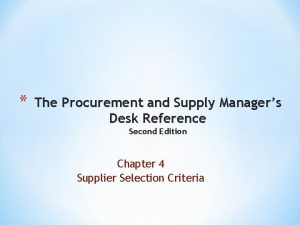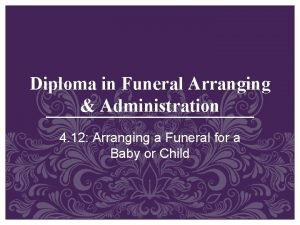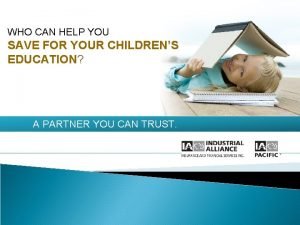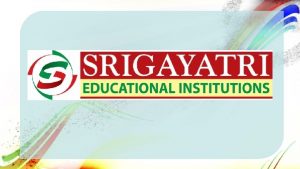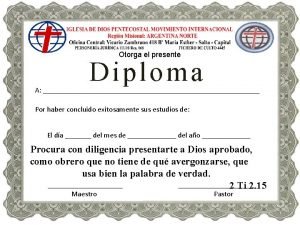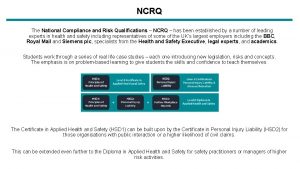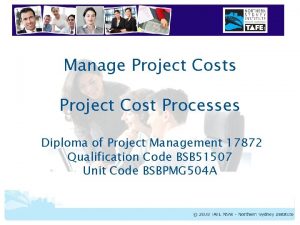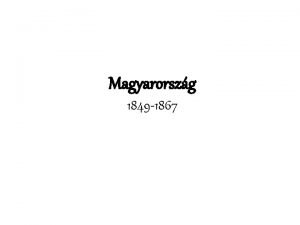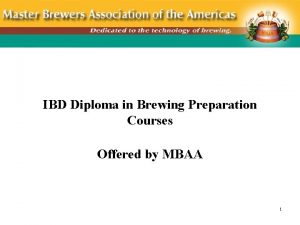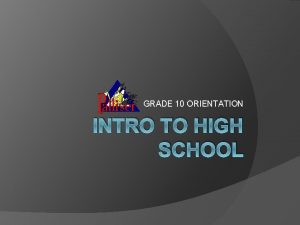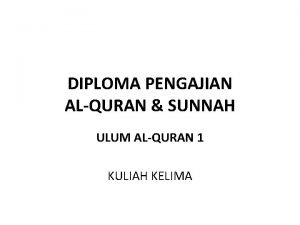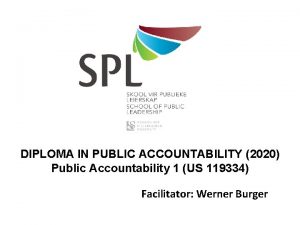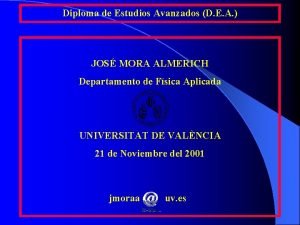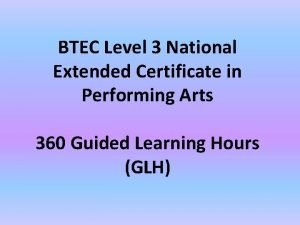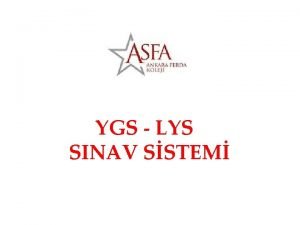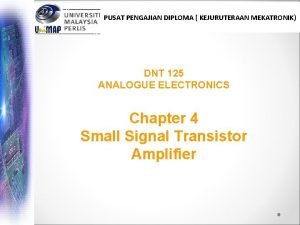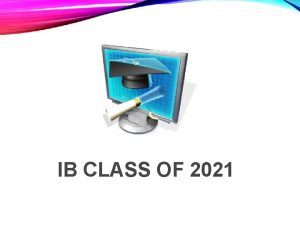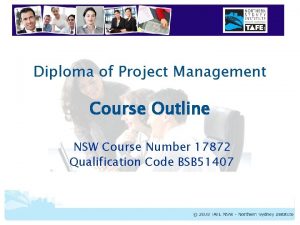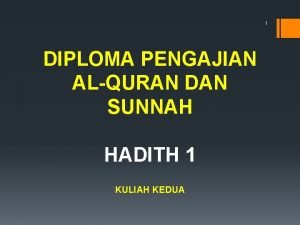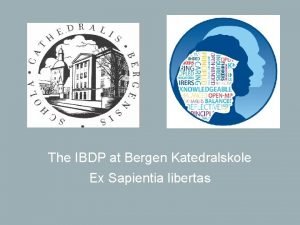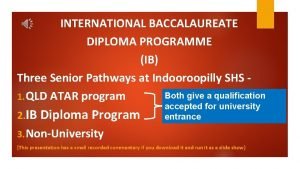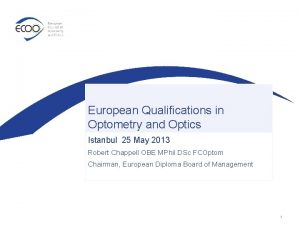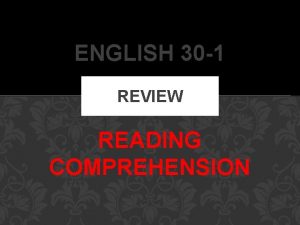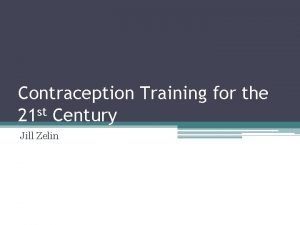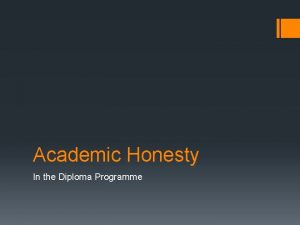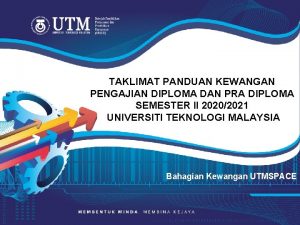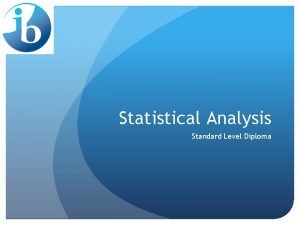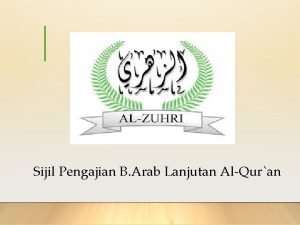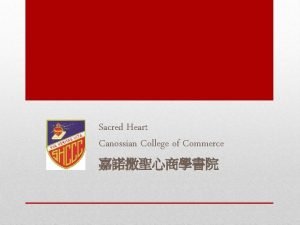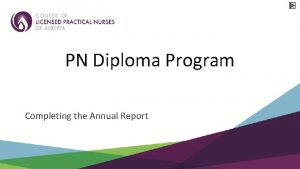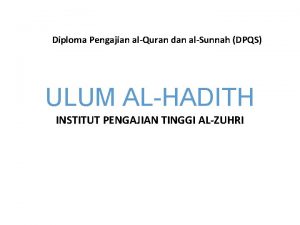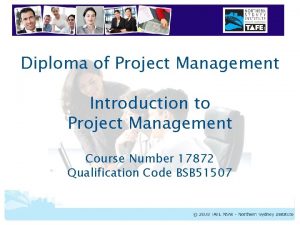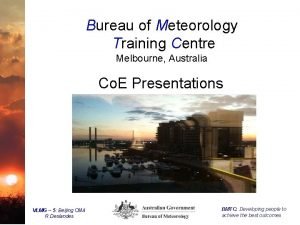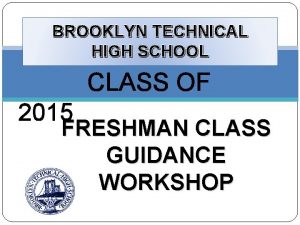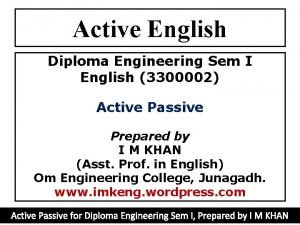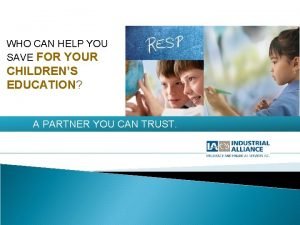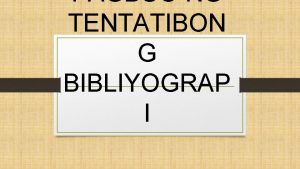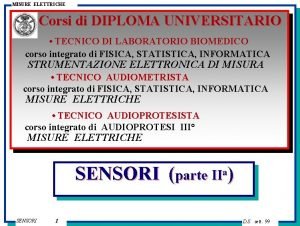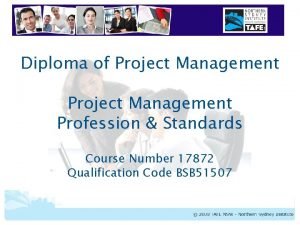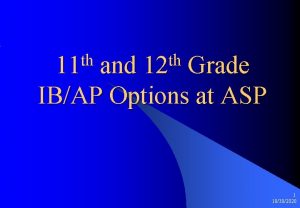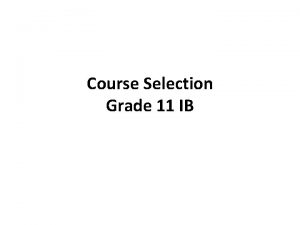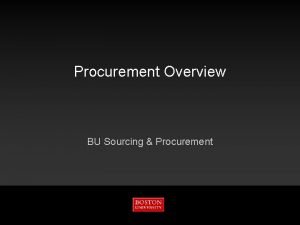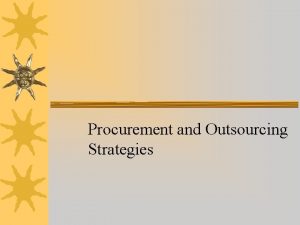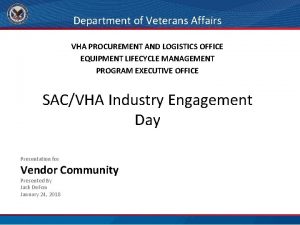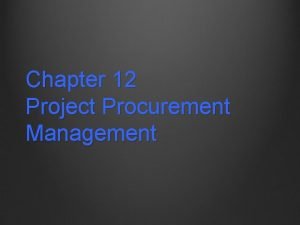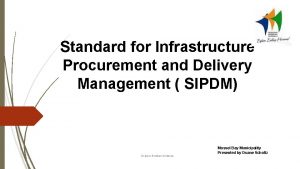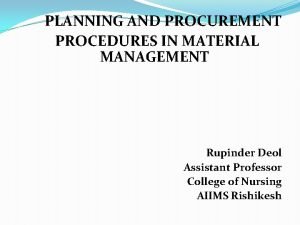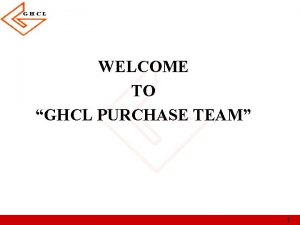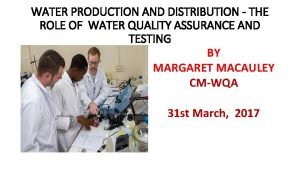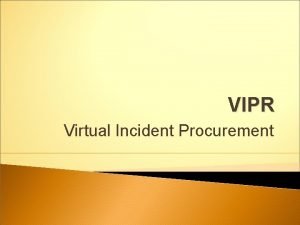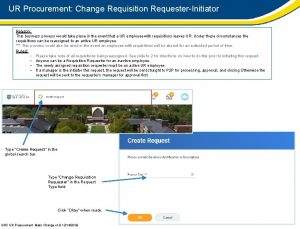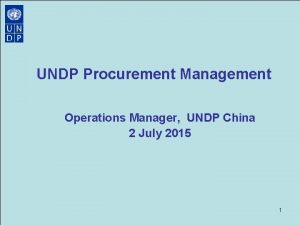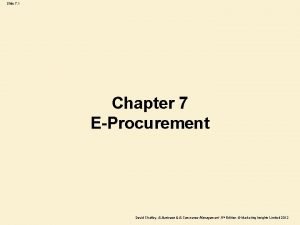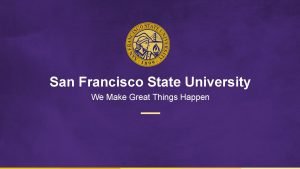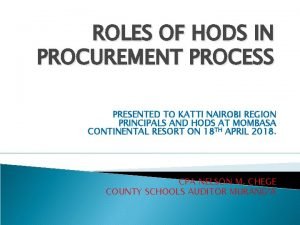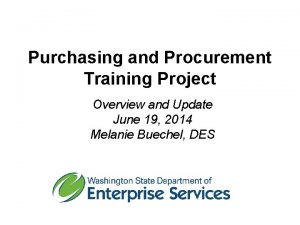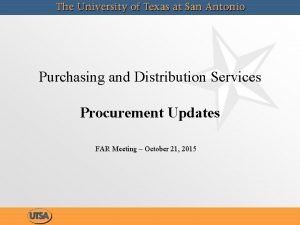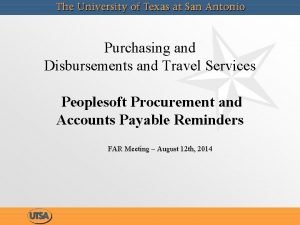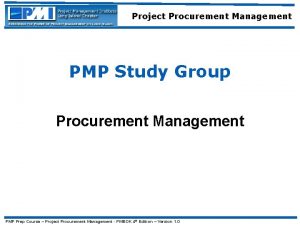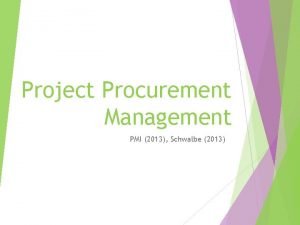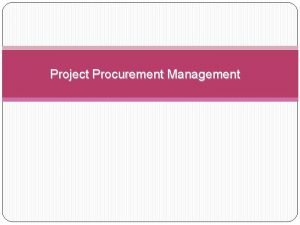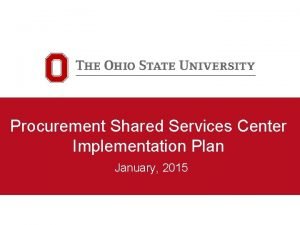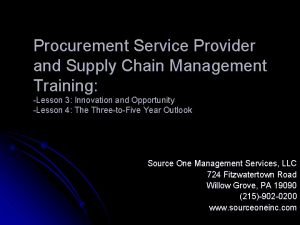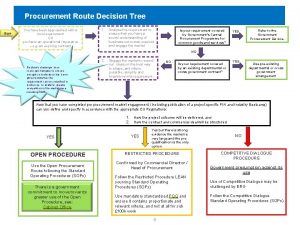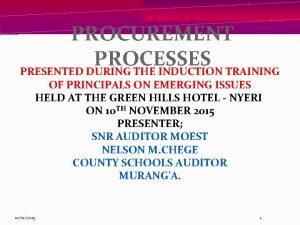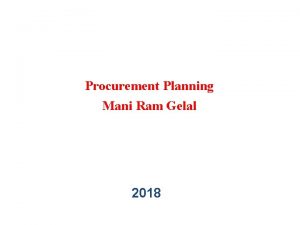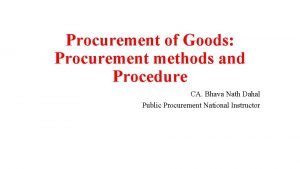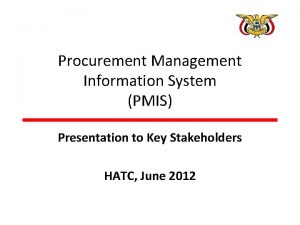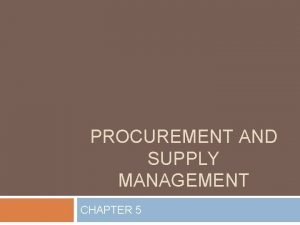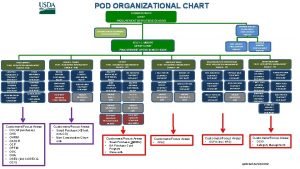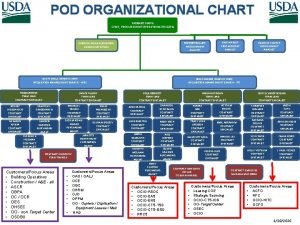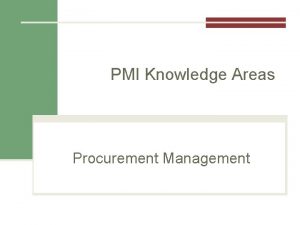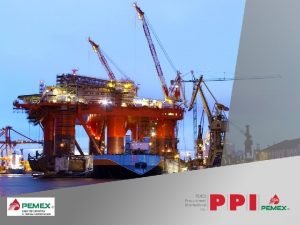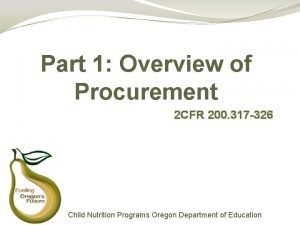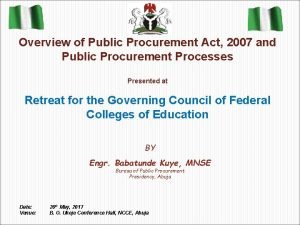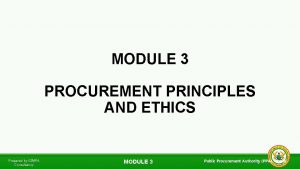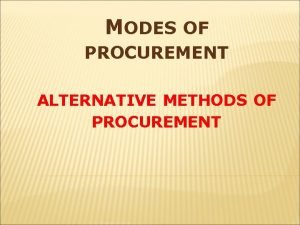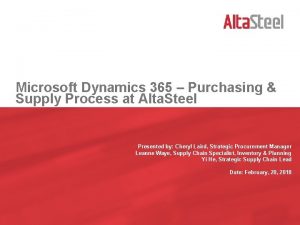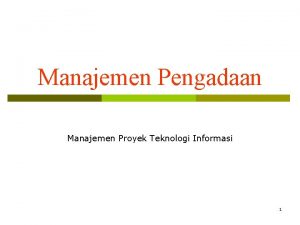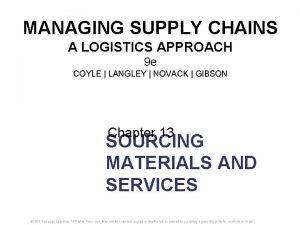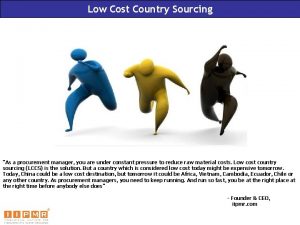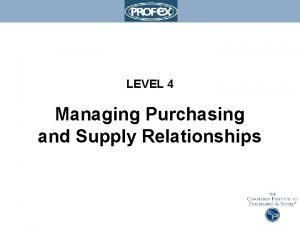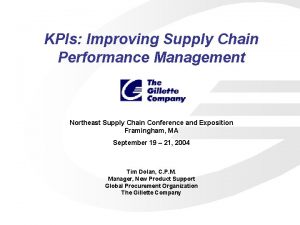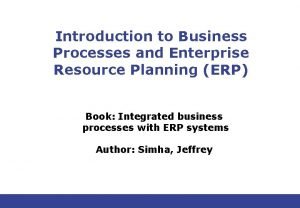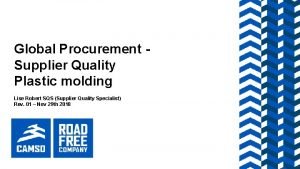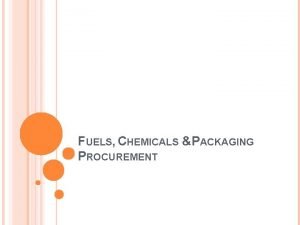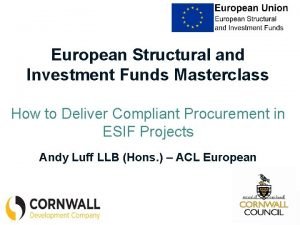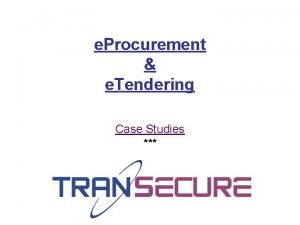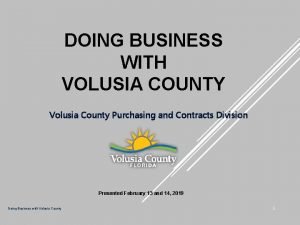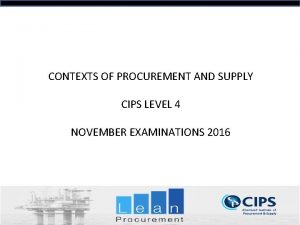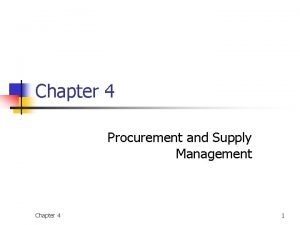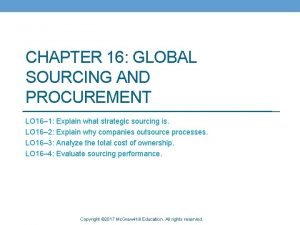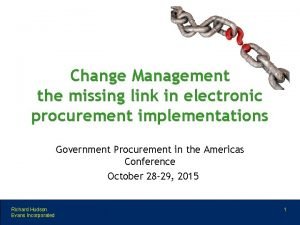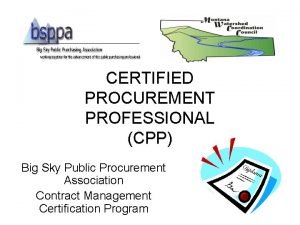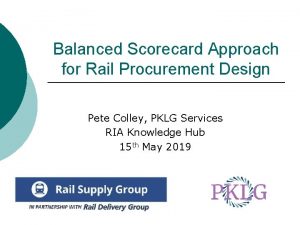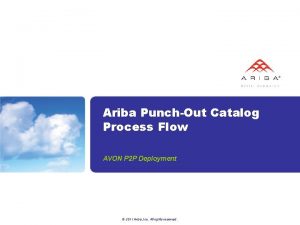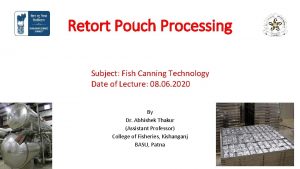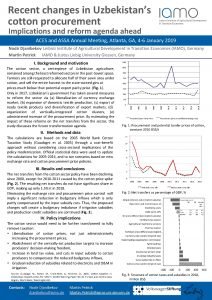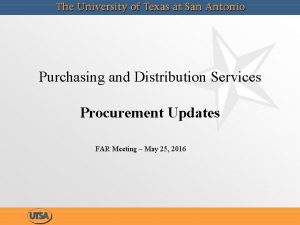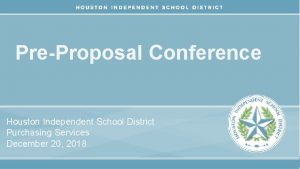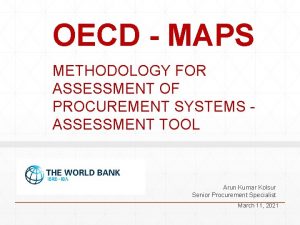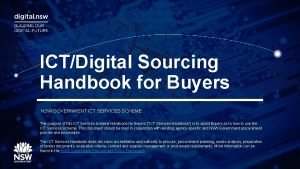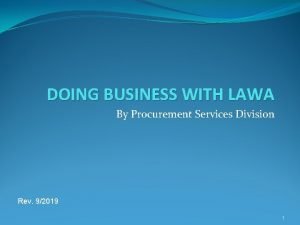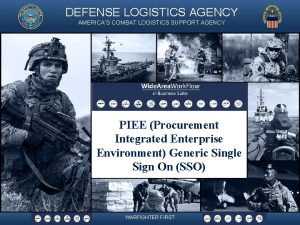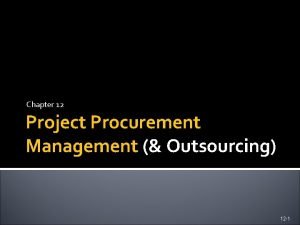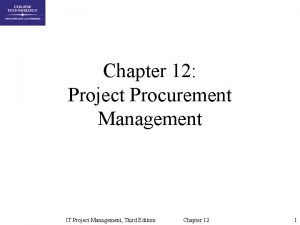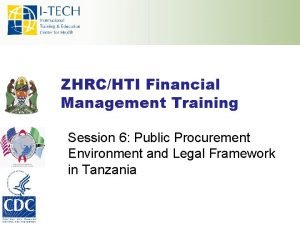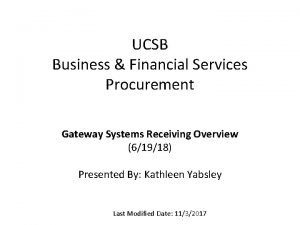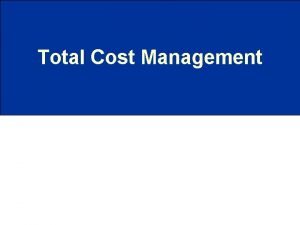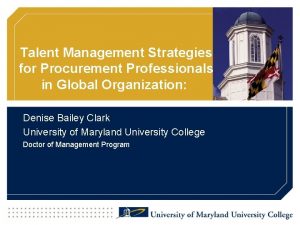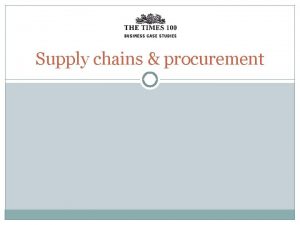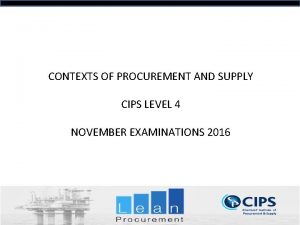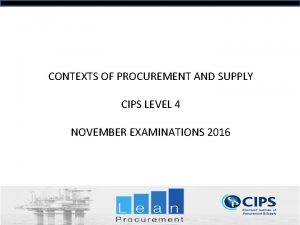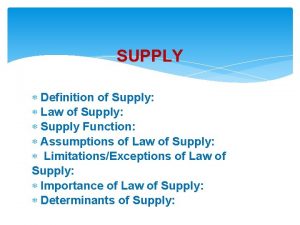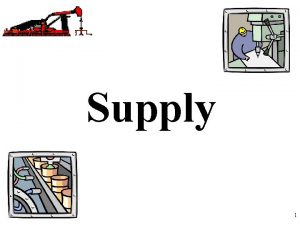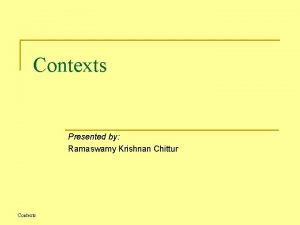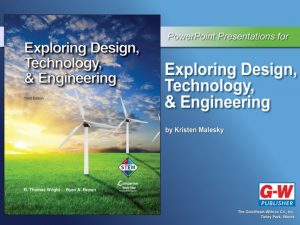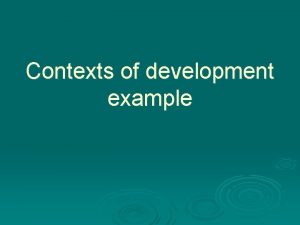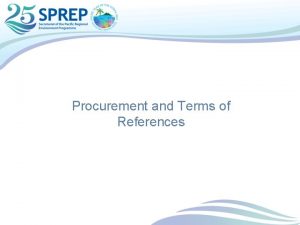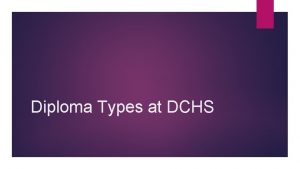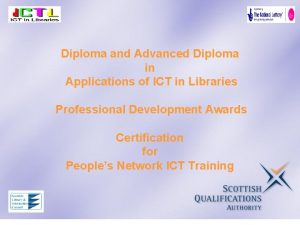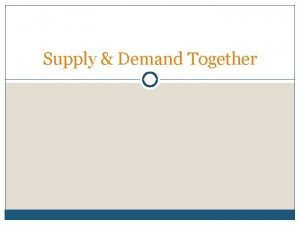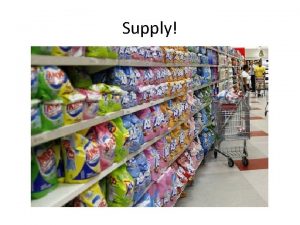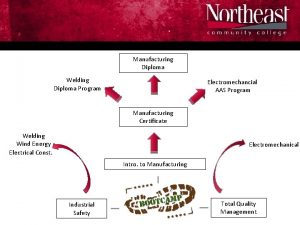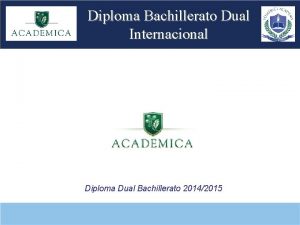Contexts of Procurement and Supply Diploma in Procurement

























































































































































































- Slides: 185

Contexts of Procurement and Supply Diploma in Procurement and Supply

Procurement Traditional definitions of purchasing and supply: • • Imply that purchasing is ‘reactive’ Imply that purchasing is ‘transactional’ Imply that purchasing is ‘tactical’ Imply that purchasing is always about ‘buying’ goods and services in return for some form of payment

Procurement and purchasing • Procurement is a wider term than purchasing • Procurement embraces a broader process than ‘purchasing’ • Procurement reflects the more proactive, relational, strategic and integrated role of the function in modern organisations

What does the procurement function do? • Supply market monitoring • Supplier evaluation and selection • Processing procurement or stock replenishment requests • Providing input to the preparation of specifications • Negotiating, buying and developing contracts • Expediting or contract management • Clerical and administrative tasks

Goods, services and works • Goods are tangible or material items, which can be consumed • Services are actions individuals or organisations perform which confer a benefit, but do not result in the ‘ownership’ of anything • Constructional works include projects such as the construction, alteration, repair, maintenance or demolition of buildings or structures; the installation of fittings; and so on

Typical proportion of costs

External and internal costs

Porter’s value chain

Production materials • Raw materials • Items extracted from the ground, such as minerals, ores and petroleum • Agricultural and forestry products • Components and assemblies • The finished output of other manufacturers upstream in the supply chain • Work in progress • Part-finished output, which is not yet ready for sale to customers

Commodity procurements • • Producers Buyers Traders Speculators

Goods for re-sale • • • Bottom line thinking Broad assortment Buying against supplier specifications Short feedback loop Technical complexity

A ‘stocking for inventory’ policy • In situations of independent demand • In situations of stable/predictable demand for lowvalue, non-perishable items • Where there is a long lead time • Where items are critical for operations • Where there is a legal requirement to hold stocks • Where inventory appreciates in value over time • Where prices are expected to rise • Where demand is seasonal

MRO and capital items CONSIDERATIONS IN MRO PURCHASES Availability Cost Ability to use standard/generic substitutes Ability to minimise stockholding Supplier service levels Post-contract maintenance service Options (buy, lease or hire) CONSIDERATIONS IN CAPITAL PROCUREMENT Total costs over life of asset Asset utilisation: lifespan, flexibility Space/access requirements Training, health and safety requirements Cost/availability of spare parts through the life of the equipment

Lease or buy? ADVANTAGES OF OUTRIGHT PURCHASE DISADVANTAGES OF OUTRIGHT PURCHASE Total cost is low, compared to rental High initial expenditure ties up capital The user has total control over the use of the asset User bears all costs and risks of maintenance, operation and disposal The asset may have residual re-sale value at the end of use Risk of technological obsolescence Capital allowances may be set against Wasteful, if equipment is needed tax, and government grants may be only for a short period (eg a available particular project)

Lease or buy? ADVANTAGES OF LEASING DISADVANTAGES OF LEASING No initial investment to tie up capital Long-term commitment to pay instalments Protects against technological obsolescence User does not have total control of asset Costs are known and agreed in advance Total cost may be higher than purchase Fewer complex tax and depreciation calculations Large organisations may get better terms by securing their own finance to purchase Hedge against inflation Contract terms may favour the lessor

Distinctive features of services • Intangibility (or in procurement terms, ‘lack of inspectability’: Baily et al) • Inseparability • Heterogeneity or variability • Perishability (or in procurement terms, ‘impracticability of storage’) • Ownership (or in procurement terms, ‘uncertainties in contractual agreements’)

Measures of service quality • • • Tangibles Reliability Responsiveness Assurance Empathy

Monitoring service levels • • Observation and experience Spot checks and sample testing Business results and indirect indicators Customer/user feedback Electronic performance monitoring Self-assessment by the service provider Collaborative performance review

Outsourcing ADVANTAGES DISADVANTAGES Supports organisational rationalisation and downsizing Potentially higher cost of services, contracting and management Allows focused investment of resources on core competencies Difficulty of ensuring service quality/consistency and CSR Gives access to specialist expertise, technologies and resources of contractors Potential loss of in-house expertise, knowledge, contacts or technologies in the service area Access to economies of scale Potential loss of control Adds competitive performance incentives Added distance from the customer or enduser Risks of ‘lock in’ to an incompatible or underperforming relationship Risks of loss of control over confidential data and intellectual property

The Kraljic matrix

The organisation as an open system

Other general objectives • • Internal customer service Risk management Cost control and reduction Relationship and reputation management

Porter’s value chain

The five rights of procurement • Quality Obtaining goods which are of satisfactory quality and fit for their purpose • Quantity Obtaining goods in sufficient quantity to meet demand maintain service levels while minimising excess stock holding • Place Having goods delivered to the appropriate delivery point, packaged and transported in such a way as to secure their safe arrival in good condition • Time Securing delivery of goods at the right time to meet demand, but not so early as to incur unnecessary inventory costs • Price Securing all of the above at a price which is reasonable, fair, competitive and affordable

What is the ‘right price’? The ‘right price’ for the supplier or seller to charge (the sales price) will be: • A price which ‘the market will bear’ • A price which allows the seller to win business, in competition with other suppliers • A price which allows the seller at least to cover its costs, and ideally to make a healthy profit

What is the ‘right price’? The ‘right price’ for the buyer to pay (the purchasing price) will be: • A price which the buyer can afford • A price which appears fair and reasonable, or represents value for money • A price which gives the buyer a cost or quality advantage • A price which reflects sound procurement practices

Factors in buyers’ decisions on price • The buying organisation’s relative bargaining power • The number of suppliers in the market and the possibility of substitute products • The type of procurement • The prices paid by competitors • The total package of benefits offered for the price • What the buyer can afford • What is a ‘reasonable’ price, based on price and cost analysis • What is a ‘fair’ (ethical and sustainable) price

The price-cost iceberg

Definitions of quality • • Performance Features Reliability Durability Conformance Serviceability Aesthetics Perceived quality

Costs of quality

Quality control • Establishing specifications, standards and tolerances for work inputs and outputs • Inspecting delivered goods and monitoring production processes • Identifying items that are defective or do not meet specification • Scrapping or re-working items that do not pass inspection

Quality management system (QMS) A QMS is designed to ensure that: • An organisation’s customers can have confidence in its ability reliably to deliver products and services which meet their needs and expectations • The organisation’s quality objectives are consistently and efficiently achieved, through improved process control and reduced wastage • Staff competence, training and morale are enhanced • Quality gains, once achieved, are maintained over time

Providing ‘the right quality’ • Selecting suppliers with quality management systems • Appraising the quality management systems and ‘track record’ of suppliers • Preparing preferred or approved supplier lists • Influencing the quality of product design • Translating design requirements into clear, accurate materials and service specifications • Developing goods inwards procedures for quality inspection and testing • Managing relationships with suppliers • Monitoring and controlling suppliers’ quality performance over time • Working with suppliers to resolve quality disputes

What determines ‘right quantity’? • • Demand for the final product Demand for procured finished items The inventory policy of the organisation The service level required Market conditions Supply-side factors Factors determining the economic order quantity Specific quantities notified to buyers by user departments, according to identified needs

How much stock should you hold? • Stocks reduce the risks of disruption to production • Stocks allow rapid replenishment of goods which are in constant use • Buyers may be able to take advantage of bulk discounts, lower prices or reduced transaction costs by placing fewer, larger orders • Buyers may be able to protect against anticipated shortages, price increases, or exchange rate fluctuations, by buying in advance of need • Stocks of finished or almost-finished goods may be prepared ready for unexpected peaks in customer demand • Stocks of finished goods may be prepared during periods of slow demand

Periodic review system

Fixed order quantity system

Pull inventory systems • • Just in time (JIT) Materials requirements planning (MRP) Manufacturing resources planning (MRP II) Enterprise resource planning (ERP)

Understanding supplier lead times • Internal lead time The lead time for the processes carried out within the buying organisation • External lead time The lead time for the processes carried out within the supplying organisation • Total lead time A combination of internal and external lead time: that is, the time between the identification of a need by the buyer to delivery of goods by the supplier

Key considerations in inbound delivery decisions • • • The correct delivery point The timelines of the delivery The exposure to risk of goods in transit The total distribution cost The environmental impact of transport The need to monitor, track or ‘expedite’ deliveries

Distribution centres

Further ‘rights’ for external procurement • • The right procurement (or the right need) The right supplier (or supply chain) The right relationship The right process

Obtaining value for money • The use of value analysis to eliminate non-essential features • Challenging user-generated specifications • Proactive sourcing • Consolidating demand • Adopting whole life costing methodologies • Eliminating or reducing inventory and other ‘wastes’ • Using IT systems to make procurement processes more efficient • International sourcing

The ‘Triple Bottom Line’ • Economic sustainability (Profit) • Environmental sustainability (Planet) • Social sustainability (People)

Integration of supply chain activities

Materials management (MM) • Materials and inventory planning • Procurement of the necessary materials, parts and supplies • Storage and inventory management • Production control

Physical distribution management (PDM) • • • Warehousing and storage Transport or distribution planning Materials handling Inventory management and control Transportation and delivery

Logistics management

Principal flows in a simple supply chain

Dyadic supply relationships

Principal flows in a (simplified) internal supply chain

A simple supply network!

A retail supply network

Tiered supply chain structures All manufacturing performed by top-level purchaser:

Tiered supply chain structures Top-level purchaser outsources most manufacturing:

Management issues in closed-loop supply chains • Effective supply base management, integration and collaboration • Effective supplier and customer relationships • Supplier selection and contract award on the basis of recycling or ecologically friendly disposal capacity • Product and packaging design to facilitate return, recycling and safe disposal • Visibility • Reverse logistical activities

Innovative value-adding strategies • • Value engineering Lean supply Agile supply Value-adding negotiations and relationships

Purchasing and supplier management PURCHASING ACTIVITY Focus on non-critical items Ordering or calling off purchases Order expediting Maintaining inventory Receipt and storage of supplies Arranging payment SUPPLIER MANAGEMENT ACTIVITY Focus on critical/strategic items Sourcing and appraising suppliers Rationalising the supplier base Developing supplier potential Early supplier involvement Negotiation Supplier relationships Monitoring supplier performance Ethical and environmental issues

Benefits of an SCM approach Reduced costs, by eliminating waste activities Improved responsiveness to customers’ requirements Access to complementary resources and capabilities Enhanced product and service quality Improving supply chain communication Sharing demand forecasting and planning information enables Just in time supply • Faster lead times for product development and delivery – ‘Agile’ supply • Better communication allows greater transparency • • •

Developing supply chain management TRADITIONAL WAYS NEW WAYS Key feature: Independence Key feature: Integration Independent of next link Dependency Links are protective End-to-end visibility Uncertainty More certainty Unresponsive to change Quicker response High cost, low service High service, lower cost Fragmented internally ‘Joined up’ structures ‘Blame’ (adversarial) culture ‘Gain’ (collaborative value-adding) culture Competing companies Competing supply chains

Why are stakeholders important? • They may seek to influence the organisation • There is strong public and regulatory pressure for business organisations to be ‘socially responsible’ • Organisations themselves increasingly follow (and publicise) ethical and CSR frameworks

Categories of stakeholders • Internal stakeholders • Connected stakeholders • External or secondary stakeholders

Internal stakeholders STAKEHOLDER Directors/managers Staff/team members or other organisation members Technical/design function Manufacture/production/operations function Sales and marketing function Finance/admin function Storage and distribution (or logistics)

Connected stakeholders STAKEHOLDER Shareholders End customers Intermediary customers (eg agents, distributors, retail outlets) Suppliers Financial institutions/ lenders

External stakeholders STAKEHOLDER Government and regulatory bodies Pressure groups (eg Greenpeace) and interest groups (eg consumer associations, trade unions) Community and society at large

Social responsibility objectives • Sustainability issues • Environmental issues • Ethical trading, business relationships and development

Environmental responsibility • Recycling and re-using of materials and waste products • Safe disposal of waste products that cannot be recycled • Supplier selection policies (and tender criteria) to support firms that conform to environmental standards • Supplier and product selection policies that reflect concern for conservation and renewal of resources • Safe and animal-friendly testing of products and materials • Concern for noise, spray, dirt, vibration and congestion in the planning and operation of transportation

Stakeholder management • Take their interests and likely responses into account • Communicate effectively with them on matters that affect them • Engage the interest, support and commitment of influential (and potentially helpful) groups • Manage potential issues and problem areas that might arouse resistance or opposition from influential groups

Mendelow’s power/interest matrix

Stakeholder position analysis • Partners: those who support the change agent • Allies: those who will support him or her, given encouragement • Fellow travellers: passive supporters • Bedfellows: people who support the agenda, but do not know or trust the change agent • Fence sitters: those whose allegiances are not yet clear • Loose cannons: people who may vote either way • Opponents: people who oppose the agenda, but not the change agent personally • Adversaries: people who oppose the change agent and the agenda • The voiceless: ‘silent’ stakeholders

Stakeholder management • Goal analysis • Desired outcomes • Stakeholder marketing and communication programmes • Relationship management • Issues management

Stakeholder management

A generic procurement cycle

Procurement process stages Pre contract award: • Identification and definition of need • Procurement planning • Development of the contract • Market survey and engagement • Appraisal and selection of suppliers • Receipt and evaluation of offers • Contact award Post contract award: • Expediting • Payment • Contract or supplier management • Ongoing asset management • Post-contract ‘lesson’ learning

Supplier relationships • • • Spot buying Regular trading Fixed or call-off contracts Single sourcing Strategic alliance Partnership

Why have structured procurement processes? • It ensures that all tasks have been performed that need to be performed • It ensures adequate co-ordination of effort between parties collaborating in a process • It helps to maintain consistency in processes and outcomes, • It prevents conflict and sub-optimal behaviour • It fosters efficiency • It supports good governance and managerial control • It supports compliance with relevant standards, law and regulation • It enables the documentation and sharing of good practice • It enables meaningful process analysis, problem-solving and improvement • It supports the systematic development of procurement staff, systems, technology and other resources • It supports the devolution of some procurement tasks to nonprocurement staff

Approaches to best practice • Best practice sharing • Applying for quality awards • Benchmarking

Specification Define the requirement Communicate the requirement Minimise risk and cost Provide a means of evaluating the quality or conformance • Support standardisation and consistency • •

A conformance specification may take the form of: • An engineering drawing, design or blueprint (technical or design specification) • A chemical formula or ‘recipe’ of ingredients and materials (composition specification) • The specification of a brand name and model name or number, if a marketed product meets the buyer’s criteria • A sample of the product • The specification of compliance with a recognised standard

A performance specification might include the following: • • The functionality, performance or capabilities to be achieved Key process inputs which will contribute to performance The operating environment and conditions How the product is required to interface with other elements of the process Required quality levels Required safety levels and controls Required environmental performance levels and controls Criteria and methods to be used to measure whether the desired function has been achieved

Procurement function contributions • • • Supply market awareness Supplier contacts Awareness of commercial aspects of procurements Awareness of legal aspects of procurements Procurement disciplines

Contract terms • Express terms are clearly stated and recognised in the contract between the parties • Implied terms are terms which are assumed to exist by virtue of common law and statute (legislation) and therefore form part of the contract – whether or not they are mentioned within it

Service level agreements • What services are included • Standards or levels of service • The allocation of responsibility for activities, risks and costs • How services and service levels will be monitored and reviewed • How complaints and disputes will be managed • When and how the agreement will be reviewed and revised

Sources of information about potential suppliers • Procurement database records and lists of preferred, approved or authorised suppliers • Supplier catalogues, sales force presentations and websites • Printed and web-based listings of suppliers and stockists; trade registers and directories; searchable databases; and specialist resources • Online market exchanges, auction and review sites and supplier/buyer forums • Trade or industry press and specialist procurement journals • Trade fairs, exhibitions and conferences • Networking with other procurement professionals

The ’ 10 Cs’ • • • Competence (or capability) Capacity Commitment Control Cash Consistency Cost Compatibility Compliance Communication

The use of competitive bidding FIVE CRITERIA FOR THE USE OF COMPETITIVE FOUR SITUATIONS IN WHICH COMPETITIVE BIDDING SHOULD NOT BE USED The value of the procurement should be high It is impossible to estimate production costs enough to justify the expense of the process accurately The specifications must be clear and the potential suppliers must have a clear idea of the costs involved in fulfilling the contract Price is not the only or most important criterion in the award of the contract There must be an adequate number of potential suppliers in the market Changes to specification are likely as the contract progresses The potential suppliers must be both technically qualified and keen to win the business Special tooling or set-up costs are major factors in the requirement There must be sufficient time available for the procedure to be carried out

Approaches to tendering • Selective tendering Potential suppliers are pre-qualified and 3– 10 suppliers are short-listed for invitation to tender • Open tendering The invitation to tender is widely advertised and open to any potential bidder

A checklist for analysing tenders 1. Establish a routine for receiving and opening tenders, ensuring security 2. Set out clearly the responsibilities of the departments involved 3. Establish objective award criteria, as set out in the initial invitation to tender 4. Establish a cross-functional team for the appraisal of each tender 5. Establish a standardised format for logging and reporting on tenders 6. Check that the tenders received comply with the award criteria 7. Check the arithmetical accuracy of each tender! 8. Eliminate suppliers whose total quoted price is above the lowest two or three quotes by a specified percentage (say 20%) 9. Evaluate the tenders in accordance with predetermined checklists 10. Prepare a report on each tender for submission to the project or procurement manager

Purchase-to-pay activities

Contract management • Contract development • Contract administration • • • Contract maintenance, updating and change control: Contracts database management Budgeting and costs/charges monitoring Purchase-to-pay procedures Management reporting Dispute resolution Managing contract performance Contract review Supplier relationship management: Contract renewal or termination

Supplier relationships management: benefits • The company incurs fewer costs of identifying, appraising and training new vendors, and fewer transaction and contracting costs of multiple sourcing and competitive bidding • Quality and other problems can be ironed out progressively • Goodwill developed with positive relationships may earn preferential treatment or flexibility from suppliers • Suppliers may be more motivated to give their best performance • Motivated suppliers may be willing to co-invest • There is less risk of supplier failure or poor performance

Vendor rating criteria • Price eg measured by value for money, market price or under, lowest or competitive pricing, good cost management and reasonable profit margins • Quality eg measured by key performance indicators (KPIs) such as the number or proportion of defects, quality assurance procedures • Delivery eg measured by KPIs such as the proportion of on-time in-full (OTIF) deliveries, or increases or decreases in lead times for delivery

A supplier evaluation form

The impact of ICT • Dramatically increasing the speed of communication and information processing • Offering wider access to knowledge and information, especially from global sources • Facilitating 24 -hour, 7 -day, global business • Supporting paperless communications, business transactions and service delivery • Creating ‘virtual’ relationships, teams and organisations

The e-purchasing process

E-procurement tools STAGE OF THE PROCUREMENT PROCESS Identifying and defining needs Sourcing the market Purchase to Pay (P 2 P) and contract management

Minimising data security risks Physical security • Physical business protection related to hardware theft • Disposal routines for old computers Data backup routines • Backing up data to removable media on a daily basis • Running data verification routines after backup routines Passwords • Develop robust password systems System upgrades • Minimise vulnerability by keeping systems as up to date as possible Firewall systems • Hardware or software security that inspects, allows, and/or blocks traffic along information networks Malicious software (malware) protection • Malware is the general term that refers to any type of malicious software, including viruses, worms, Trojans, adware and spyware. • Most threats can be removed by dedicated software protection and removal tools Authorisation procedures • Data integration to enable matching of records (eg invoices with orders and goods received notes) and identification of discrepant data • Automatic routing of e-requisitions, procurement orders and invoices to appropriate budget holders for managerial sign-off or authorisation

E-sourcing tools • • E-catalogues Supplier portals and market exchanges E-tendering E-auctions • Auctions • Reverse auctions • Online supplier evaluation data

Using the internet to identify potential suppliers ADVANTAGES DISADVANTAGES Global, 24/7 available source of data Excess volume of information Low-cost, fast, convenient info search Information may be unreliable/outdated Information generally frequently updated Difficulty verifying data, source credibility Access to small, niche, global suppliers Limited ability to ‘sample’ product/service Access to customer feedback, reports, ratings, certification data etc. Supports global sourcing – creating logistical challenges, risks etc. Some ability to ‘sample’ product/service (eg virtual tours, digital samples) May discriminate against developing country suppliers Facilities for direct contact (eg via email)

E-tendering • The invitation to tender (ITT) is published on the buyer’s etender web portal; bid-related documents are also posted • Suppliers respond to the ITT by sending their bids using secure email • Buyers can observe and manage the tendering process through a ‘front end’ web function • In-built security features prohibit access to any of the tender responses until a specified time • The system may include automatic scoring and evaluation capability • Successful and unsuccessful bidders can be automatically notified of the award

Advantages of e-sourcing in the public sector BENEFIT EXPLANATION Process efficiencies Reducing time and effort spent on tendering and contract management; reduced paperwork; fewer human errors Compliance Eg with the provisions of the Efficiency Review and the National Procurement Strategy for Local Government Cost savings Reducing the direct costs of tendering (for both buyer and suppliers); more efficient comparison, supporting savings through competition Collaboration Making it easier for purchasers to work together on common sourcing projects across different departments and regions: creating ‘virtual buying organisations’ to increase bargaining power Strategic focus Allowing purchasing professionals to focus on value-added and strategic procurement activity (such as supplier screening, supply base development and relationship management), rather than administration

E-P 2 P Tools • • Electronic data interchange Online track and trace Expediting by exception Receipt and inspection Electronic payment Contract management systems Database information

Benefits from E-P 2 P systems • Streamlining and improving the flow of work through the system potentially both reduces costs and enhances the cashflow cycle. It may also increase business responsiveness in general. • The interface between the organisation and its suppliers is improved. • Error rates, associated with data input, transfer and processing, are reduced. • Procurement and finance personnel are freed from purely administrative burdens. • The system provides for procedural consistency, compliance and control.

Why is procurement governance important? Procurement staff: • potentially control large sums of organisational funds • are faced by many opportunities to commit financial fraud or to misuse systems or information for personal gain • their decisions typically benefit some suppliers over others – creating an incentive for suppliers to try and influence those decisions

Key elements of a governance framework • • Regulatory mechanisms Checks and balances Prevention Correction

Governance mechanisms • A strong internal control environment • Codes of ethical conduct • Fair, ethical, transparent and consistently applied procedures • Budgeting, control and monitoring of procurement spend • Clearly defined roles, responsibilities, accountabilities and reporting structures • Controls over the authority levels of individual buyers • Clear requirements for approvals and authorisations • Clear audit trails • The segregation of procurement duties • Rotation of project buyers • Controls over preferred supplier lists and single-sourcing deals • E-procurement tools to minimise cash transactions • Physical security measures to protect assets • The effective vetting, selection, supervision and development of staff in positions of responsibility • The use of standard terms and conditions of contract • Internal audit of procurement processes, decisions and controls • Encouraging suppliers and employees to report ethical breaches • Establishing an ethics forum or committee to discuss conflicts of interest and ethical issues arising in the course of work

What are ‘ethics’? Ethical issues may affect businesses and public sector organisations at three levels: • At the macro level issues of the role of business and capitalism in society • At the corporate level issues which face an individual organisation as it formulates strategies and policies about how it interacts with its various stakeholders • At the individual level issues which face individuals as they act and interact within the organisation and supply chain

Ethical codes and standards • Members must disclose any personal interest which might impinge on their work activities, or which might appear to do so. • Members must respect the confidentiality of information and must not use information received for personal gain. The information they provide should be true and fair. • Members should avoid any arrangements which might prevent fair competition. • Except for small-value items, business gifts should not be accepted. • Only modest hospitality should be accepted. • Any doubt on these last two points should be discussed with the individual’s superior.

Objectives of the ILO Decent work for all Decent work considers the aspirations of people in their working lives, such as their aspirations for opportunity and income; rights, voice and recognition; and fairness and gender equality Employment creation The ILO identifies policies that help create and maintain decent work and income Fair globalisation Globalisation enables global economic growth – but may also exploit some of the poorest in society. The ILO seeks ways of ensuring that the benefits of globalisation reach more people Rights at work Four fundamental principles relating to workers’ rights: freedom of association; elimination of forced labour; elimination of discrimination; and elimination of child labour Social dialogue The ILO supports negotiation, consultation and exchange of information between, or among, representatives of governments, employers and workers on issues of common interest Social protection Access to an adequate level of social protection is recognised as a basic right of all individuals Working out of poverty People should have the ability to improve their situation not only in terms of income but also in terms of respect, dignity and communication

The Ethical Trading Initiative (ETI) 1. Employment is freely chosen 2. Freedom of association and the right to collective bargaining are respected 3. Working conditions are safe and hygienic 4. Child labour shall not be used 5. Living wages are paid 6. Working hours are not excessive 7. No discrimination is practised 8. Regular employment is provided 9. No harsh or inhumane treatment is allowed

Fair Trade standards • Creating opportunities for economically disadvantaged producers • Integrity • Capability building • Fair payment • Working conditions • Gender equity and children’s rights • The environment

Procurement monitoring and reporting • Continuous monitoring • Periodic audits and reviews • Annual audits and reviews

Procurement audits • To monitor and enforce compliance with the procurement policies laid down by senior management • To ensure that the organisation is using good or best practice procedures, working methods, tools and techniques • To monitor and measure the extent to which organisational resources are being used effectively, efficiently and with an eye to best value • To support the prevention and detection of fraud, error, mismanagement of funds, inadequately managed risks and other governance problems

Influences on procurement status • Leverage the perceived power of procurement to make a measurable value contribution, notably by enhancing profitability • Focus the perception of procurement as having a transactional focus, a commercial focus or a strategic focus • Structural factors the position and visibility of the procurement function in the organisation: • Professionalism implies a businesslike attitude; technical competence, often based on systematic training and education; and adherence to a code of professional ethics

Corporate policy and procedures The impact of corporate policy and procedure on procurement decision-making depends in part on the nature of the decision in each case: • Routine decisions • Adaptive decisions • Innovative decisions

Compliance requirements • Quality standards and tolerances required to be accredited by various British and international quality standards, or to receive the European Community (CE) quality mark • Quality standards and tolerances required for product safety • Controls on the use, storage and transport of substances and materials which may be dangerous to health • Environmental protection law and regulation, dealing with issues such as the safe disposal or recyclability of waste and end-of-life products

Typical procurement roles ROLE Head (or Director) of Procurement Senior Procurement Manager (SPM) Procurement Manager(s) Contracts Manager(s) Supplier Manager(s) Expediters Procurement Analyst or Research Manager

Delegation for procurement A typical example of a scheme of delegation: TRANSACTION TYPE Low value Intermediate value High value VALUE CATEGORY PROCEDURE AUTHORISER <£ 1 k Goods/Services/ Works Single verbal/written quotation Local officer <£ 5 k Goods/Services Single written quotation Local officer <£ 10 k Works Single written quotation Local officer Goods/Services Three written quotations Section manager £ 10 k–£ 50 k Works Three written quotations Section manager £ 50 k – EU threshold Goods/Services/ Works Sealed tender Department head Over EU threshold Goods/Services/ Works EU tender exercise Procurement Unit £ 5 k–£ 50 k

Authorisations and sign-offs Authorisations or sign-offs may be required: • • • When a requisition is originated in a user department Before a specification is released to a supplier When the purchase order is completed When the supplier’s invoice is received Contract changes must be authorised by the relevant contract manager

Links with other functions INTERNAL CUSTOMER INVOLVEMENT IN THE PROCUREMENT PROCESS Design and engineering • • Production/operations • • Accounting and finance • Budget preparation, and monitoring of actual input costs against budget • Administration of procurement • Stock valuation, stocktaking and insurance of stock Marketing • Communication with key downstream stakeholders • Market, customer and competitor research • Customer expectations re delivery deadlines, impacting on management of cycle times Value engineering and value analysis Quality assurance Evaluation of availability and price of materials Preparation of specifications Make or buy decisions Preparation of delivery schedules Control of inventory and scrap Co-operation in implementing world class manufacturing and supply techniques • Demand/inventory planning to minimise disruption to operations

Business process flows across an organisation

Effective organisation structure • Clear paths of reporting and accountability • Effective mechanisms for multi-directional information flows and co-ordination • Effectively short chains of decision-making • Minimal duplication of effort • Soft ‘vertical’ barriers between functions • In-built flexibility

Functional organisation

Geographical organisation

Product (or category) organisation

Different structural forms ORGANISATION ADVANTAGES DISADVANTAGES Functional • • • Geographical • • Product/brand/ customer • • • Pools and focuses specialised skills and knowledge Share specialised technology and equipment Facilitates the recruitment, training and management of specialist staff Avoids duplicating functions • Focuses on inputs/processes rather than outputs/customers Creates vertical barriers to crossdisciplinary communication Decision-making at the interface between • organisation and local stakeholders • Cost-effective (because shorter) lines of supply and communication to local markets or plants Duplication of functional activities Loss of standardisation, due to local differences Clearer accountability for the profitability • of different products/brands/customer groups • Specialisation of production and marketing expertise Coordination of different functions by product managers Increased managerial complexity and overhead costs Possible fragmentation of objectives and markets

Procurement as a support or service function • It may have direct responsibility for inbound and/or outbound logistics, or may manage the outsourcing of those functions • It serves operational and service activities by fulfilling the ‘five rights of purchasing’ • It supports marketing and sales by providing product and delivery information, sourcing marketing services, or advising marketing staff on how to source requirements for themselves

Internal consultancy operational mechanisms • Established procurement policies and procedures • Preferred and approved supplier lists, framework agreements and call-off contracts • Purchasing research and information • Standard terms and conditions in supply contracts • Negotiation services and skills • Management of supplier and supplier relationships

Four stages in the development of procurement • Passive Procurement has no strategic direction, and mainly reacts to the requests of other functions. Its function is mainly clerical. • Independent: Procurement adopts the latest procurement techniques and processes, and its own functional strategies. The focus is mainly on functional efficiency, with contribution measured in terms of cost reduction and supplier performance. • Supportive: Procurement supports the firm’s competitive strategy by adopting techniques (such as just in time or lean supply) and products which strengthen its position. Its role is now that of a strategic facilitator, measured by contribution to competitive objectives. • Integrative: Procurement’s strategy (along with those of other functions) is fully integrated into the firm’s overall strategy. Its role is that of a strategic contributor, and is measured by strategic contribution. The emphasis is on cross-functional information-exchange and understanding.

Factors in structuring procurement • The size, nature and role of the procurement task in the organisation • Alignment with corporate structure and strategy • The structure and environment within which procurement operates • The strategic objectives of the procurement function

Advantages of centralised purchasing • • Specialisation of procurement staff Potential for the consolidation of requirements Greater co-ordination of procurement activities Greater standardisation of specifications More effective control of procurement activity Avoidance of conflict between business divisions Access to specialist skills, contacts and resources

Advantages of decentralised or devolved procurement • Better communication and coordination between procurement and operating departments • Customer focus • Quicker response to operational and user needs and environmental changes and problems by local buyers • Knowledge of, and relationships with, locally based suppliers • Smaller purchase quantities • Accountability • Freeing central procurement units to focus on higher-level, value-adding tasks

Organisation of a small procurement department

Organisation of a medium-sized procurement department

Organisation of a large procurement department

Mixed structures LOCAL PROCUREMENT FUNCTION CENTRALISED PROCUREMENT FUNCTION Small order items Determination of major procurement and supply chain policies Items used only by the local division Preparation of standard specifications Emergency procurements Negotiation of bulk contracts for a number of divisions Items sourced from local suppliers Stationery and office equipment Local procurement undertaken for social Procurement research sustainability reasons Procurement of capital assets Procurement capability development

Hybrid models and approaches CLAN (centre-led action network) SCAN (strategically-controlled action network) Lead buyer approach Business partner approach

When to outsource procurement CIRCUMSTANCES WHAT ACTIVITIES TO OUTSOURCE Procurement (or ‘purchasing’) is a peripheral • Purchase orders rather than a core activity • Locally and nationally procured needs • Low-value acquisitions • Brand name requirements • Call-offs against framework agreements • Administration and paperwork associated with purchasing needs The supply base is small and based on • Well-defined or limited tasks proven cooperation, and there are no supply • Jobs that are easily separated from other restrictions tasks • Jobs that have no supply restrictions The supplier base is small, providing nonstrategic, non-critical, low-risk items • Outsource purchasing to specialist purchasing and supplier organisations, or to buying consortia

Outsourcing procurement Benefits Challenges • The freeing up of resources • The organisation loses a critical commercial skill and knowledge • The ability to draw on procurement knowledge, experience, expertise, base contacts, systems and technology • The organisation may lose control • The potential for third party over vital data and intellectual purchasers to aggregate demand property and consolidate orders for different • An additional management layer is clients needed to manage the outsource • The re-focusing of remaining provider internal procurement staff on strategic issues • Greater flexibility to adjust to peaks and troughs of demand for procurement activity

Consortium procurement Benefits Challenges • Enhanced bargaining power • A consortium can establish framework agreements, simplifying purchase administration for members • Consortium members can pool expertise, knowledge and contacts • Costs and effort associated with communication and coordination, and staff/policy development • Transparency between consortium members • Consortia may suffer from lengthy negotiation and decision processes • Aggregated demand may create very large contracts • Members are not obliged to purchase to the agreed specification • Very large consortia may fall foul of laws and regulations

The impact of ICT • Dramatically increasing the speed of communication and information processing • Offering wider access to environmental and supply market information • Facilitating 24 -hour, 7 -day, global business • Supporting paperless communications, business transactions and service delivery • Offering opportunities for cost savings • Freeing up buyers’ time for creative and strategic aspects of their roles • Enhancing management information • Creating ‘virtual’ supplier relationships, teams and organisations

Inventory management systems • Demand management: ensuring that supplies are available in the right quantities at the right time • Forecasting demand in order to avoid over-stocking • Controlling stock levels to avoid over-stocking and production ‘bottlenecks’ due to stockouts • Ensuring that supplies are replenished in accordance with procurement policies • Developing cost-effective systems and procedures for ordering and procurement of supplies • Controlling the receipt, inspection, storage and issuing of supplies to users • Ensuring that stocks are safe and secure from deterioration, damage, theft or obsolescence

Inventory management systems • Capturing goods inwards information accurately, and integrating this information with stock balance, contract management and payment systems • Recording stock movements and locations • Translating issue requisitions into stock ‘picking and packing’ tasks • Maintaining stock balances and stock valuations • Triggering automatic replenishment requisitions • Monitoring productivity and utilisation • Maintaining stock integrity • Producing evidence of stock movements for invoice verification and audit trails • Producing management reports using any or all of the above data

Management information tools • Databases and database management capturing and storing data in a structured way, so that they can be shared by different users, and interrogated flexibly for a variety of applications • Decision support systems eg spreadsheets and computer models, used to examine the effect of different inputs and scenarios on the outcomes of a plan or decision • Management information systems integrated systems for recording, storing and analysing a wide range of sales, purchase, point-of-sale, inventory, maintenance, HR, financial and business intelligence data, to support management decisionmaking

The MRP process

Extranet benefits • Assists in achieving improved supply chain integration via the use of online ordering, order tracking and inventory management • Reduces operational costs • Improved collaboration and relationship potential • Suppliers can directly access authorised business information • Provides a single user interface between business partners • Improved security of communications

Web-enabled mobile telecommunications benefits • A wide range of business activities can be undertaken outside the office or on the move • Buyers and suppliers have continuous access to key contacts, for improved customer service, without having to leave messages and experience call-back delays • Mobile e-commerce, via the internet, enables users to download data and access websites both to facilitate conventional procurement and for e-procurement

Internet benefits • Wider choice of suppliers, including global and small suppliers • Savings in procurement costs, through electronic communication, greater accuracy and electronic transaction processing • Support for low inventory and efficient stock turnover • Improved supply chain relationships and coordination, arising from better data-sharing

Ways of classifying organisations • By structure and ownership: • Private sector • Public sector • The third sector – voluntary sector – subscription-paid sector • By primary objective: • Profit-oriented organisations • Not-for-profit organisations • By activity: • • Extraction of raw materials Generation of energy Manufacturing Retail • By size: • Health care, • Information technology • Media • …and so on • Small and medium enterprises (SMEs) • Multinational corporations (MNCs)

The private and public sectors In the private sector: • Organisations are owned by their investors, and controlled by directors or managers on their behalf • Activity is funded by a combination of investment, revenue and debt • The primary purpose is the achievement of commercial objectives • Competition is a key factor • The core ‘constituency’ served by firms is shareholders, customers and employees, all of whom are involved with the firm by choice In the public sector: • Organisations are owned by the government on behalf of the State, which represents the public • Activity is financed by the state, mainly via taxation – as well as any revenue the organisation’s activities may generate • The primary purpose is achieving defined service levels • There has traditionally been little or no competition • The ‘constituency’ of concerned stakeholders is wider and more diverse

Public and private sector purchasing AREA OF DIFFERENCE PRIVATE SECTOR PUBLIC SECTOR Objectives Usually, to increase profit Usually, to achieve defined service levels Responsibility Buyers are responsible to directors, who in turn are responsible to shareholders Buyers are responsible ultimately to the general public Stakeholders Purchasing has a defined group of stakeholders to take into account Purchasing has to provide value to a wider range of stakeholders Activity/process Organisational capabilities and resources used to produce goods/services Add value through supply of outsourced or purchased products/services Legal restrictions Activities are regulated by company law, employment law, product liability law etc Most of this applies equally to public sector, but additional regulations are present too Competition There is usually strong competition between many different firms There is usually no competition Value for money Maintain lowest cost for competitive strategy, customer value and profit maximisation Maintain or improve service levels within value/cost parameters.

Public and private sector purchasing AREA OF DIFFERENCE PRIVATE SECTOR PUBLIC SECTOR Diversity of items Specialised stock list for defined product/service portfolio Wide diversity of items/resources required to provide diverse services Publicity Confidentiality applies in dealings between suppliers and buyers Confidentiality is limited because of public interest in disclosure Budgetary limits Investment is constrained only by availability of attractive opportunities Investment is constrained by externally imposed spending limits Information exchange Private sector buyers do not exchange Public sector buyers are willing to information with other firms exchange notes and use shared epurchasing platforms Procurement policies/procedures Tend to be organisation-specific Supplier relationships Emphasis on long-term partnership development, to support value chain Tend to follow legislative directives Compulsory competitive tendering: priority to cost minimisation and efficiency

Classifying industry sectors • Primary industries are concerned with extracting natural resources or producing raw materials • Oil and mineral extraction (mining) • Agriculture • Forestry • Secondary industries are engaged in transforming raw materials into end components, assemblies or finished products • Manufacturing • Engineering • Construction • Tertiary industries are those engaged in the development and provision of services • Professional services • Financial services • Transport

Procurement requirements for agriculture • Agricultural machinery (tractors, harvesters, irrigation equipment and so on) • Agricultural chemicals (such as pesticides and fertilisers) • Start-up breeding stocks (seed, plant seedlings or breeding animals), for producers • Feed (for livestock) • Consumables • Packaging or containers • Support services (logistical, financial and technical)

Procurement requirement for manufacturing organisations • Raw materials, which are processed in some way in order to create finished products for consumers or products for sale to other manufacturers • Components which are assembled to create finished products for consumers or subassemblies or modules for incorporation into further assembly processes • Subassemblies or modules, put together by another manufacturer and bought in for ‘final assembly’ and finishing

Types of manufacturing • • • Project work Jobbing production Batch manufacturing Mass production Continuous process production

Challenges for the construction industry • A poor reputation for quality, delivery, cost control and health and safety • Pressure to reduce its very high environmental impacts and to contribute to sustainability targets • A downturn in the housing and commercial property market, due to global recession • An adversarial supply chain climate, and fragmented supply chains • The use of outsourced, subcontracted and casual labour

The technology sector • The value of bought-out materials, as a proportion of total expenditure, is typically high • The sector is characterised by large-scale research and development, which implies a large capital base for companies wishing to compete effectively • Late customisation has become a source of competitive advantage for some technology brands, such as Dell

Services most commonly used by business organisations • Personal eg editing, translation • Professional eg consultancy, legal, medical, insurance • Support eg administrative, financial, IT management, procurement, logistics, waste management, catering, security • Personnel eg recruitment and selection, training and development, welfare • Construction eg building repair, alteration and maintenance

Features of retail procurement • Bottom line thinking Buyers must focus on buying what will sell at good profit margins. • Broad assortment One of the functions performed by wholesalers and retailers is to make available to customers a wide range of goods offered by many different manufacturers. • Buying against supplier specifications Retailers will generally buy what is available on the market, as described by the suppliers. Changing suppliers is therefore easier for the retailer, and supplier relations tend to be less durable. • Short feedback loop In resale contexts, buying a product and selling it are close together in time. • Technical complexity In retail organisations, the items purchased are usually of low technical complexity.

Procurement staff in the retail sector: other activities • • Market research activity Setting expenditure budgets Selection of products (as well as suppliers) Monitoring of promotional activity and product sales performance

Public sector organisations • Government departments • Local government authorities • Quasi-Autonomous National Government Organisations (QUANGOs) • Public corporations • Municipal enterprises

Objectives of public sector organisations • To deliver essential public services • To encourage national and community development • To pursue socio-economic goals

The National Procurement Strategy for Local Government • Better quality services through sustainable partnerships • A mixed economy of service provision, with ready access to a diverse and competitive range of suppliers • Achieving continuous improvement by collaborating with partners • Greater value from a corporate procurement strategy • Realising community benefits • Stimulating markets and driving innovation in the design, construction and delivery of services

Regulator responsibilities • Highlighting and advising on best practice, quality standards and service levels • Reviewing and evaluating government strategies • Receiving reports and returns on performance, and publishing evidence-based findings • Monitoring and auditing organisational activity for compliance to standards • Helping customers to make informed choices and, where necessary, complaints • Communicating and promoting the work of the sector to the public

Public sector procurement regulations • • EU procurement directives Anti-corruption law Freedom of information law Review by the National Audit Office (central government and public bodies) and the Audit Commission (local government authorities)

Public Contracts Regulations 2006 • • • Advertising Contract award procedures Award criteria Right to feedback (debrief) Other provisions

Public sector purchasing challenges • Public sector buyers generally have the overall objective of achieving defined service levels • They are responsible ultimately to the general public • They have to satisfy a wider range of stakeholders • They may have a wider range of activities • They are subject to established procurement procedures, and legislative directives • They will often be subject to budgetary constraints, cash limits and/or efficiency targets

Setting New Standards • Integrated lifecycle procurement processes (or whole life contract management) • Better management of risk • Use of cross-functional teams • Information sharing and collaboration • The development of supplier relationships and a supply chain management orientation • Cost reduction • The development of professional skills • Performance measurement

Public accountability • The National Audit Office Scrutinises public spending on behalf of Parliament, with a programme of regular reviews covering central government departments and a wide range of other public bodies. • The Audit Commission Performs a similar role in relation to local government authorities. • The Public Accounts Committee (PAC) Audits and scrutinises the probity of expenditure and value for money obtained

Value for money Guidelines from Treasury and the NAO in 2004: • More efficient processing of transactions and reduced processing overheads • Getting better VFM for goods and services purchased • Direct negotiation with suppliers • Collaborative or consortium buyers • Improving project, contract and asset management • Making procurement decisions on the basis of long-term value • Combining competition with innovative procurement methods (while managing risks effectively) • Utilising e-procurement and good practice • Using tools to promote and measure VFM gains

Public private partnerships • • • Design-Build contract Build-Operate contract Turnkey Operation and Maintenance contract Private Finance Initiative

The constitution of private sector organisations • An individual may carry on a business as a sole trader • A group of individuals may carry on a business together by legal agreement, as a partnership • A potentially very large number of people may carry on a business according to specific legal requirements for ‘incorporation’ as a company.

Evaluating sole tradership ADVANTAGES DISADVANTAGES Few costs or legal requirements to establish the business The proprietor is personally liable for the business’s debts No public accountability (though financial records are required for tax purposes) It may be difficult to get finance for the business (eg a loan by personal guarantee) The proprietor controls all decisions for the business – and enjoys all the profits Resources are limited to what the proprietor can personally generate

Evaluating partnership ADVANTAGES DISADVANTAGES Partners contribute capital and expertise Decision-making has to be shared/negotiated Partners share managerial and financial responsibilities and liability Profits have to be shared among the partners With greater asset backing, it is often Partners are generally personally easier to raise loans than for a sole liable ‘without limit’ for the trader partnership’s debts Suits professions, as members are prohibited from practising as limited companies

Evaluating incorporation ADVANTAGES DISADVANTAGES Limited liability protects owners from Expense and red tape of personal liability for contracts and incorporation, and the constraint of a debts written constitution Shares are a stable source of finance: Subject to regulation eg re public the amount of capital is unaffected by disclosure (in financial reports and trading, and is not subject (like loans) accounts etc) to finance costs Directors provide the expertise the business needs, without ‘diluting’ ownership Share trading can result in unwanted change of ownership

Sources of finance in the private sector • Initial capital investment by the owners of the business or by venture capitalists • Share capital: that is, the issue of shares in the company • Retained profits • Loan finance, such as bank overdraft facilities, or bank loans and debentures • The sale of unneeded assets • Government grants

Shareholder value The aim of profitability is to generate a return on the value of shareholders’ investment of capital in the business, in the form of: • Dividends, through which a share of profits is distributed directly to shareholders • Growth in the capital or equity value of shareholders’ investment, through: • Retained profits being reinvested in the business • Maintaining or enhancing the value of the company’s shares • Maintaining or enhancing the value of the company’s assets

Corporate social responsibility (CSR) • Law, regulation and Codes of Practice impose certain social responsibilities on organisations • Voluntary measures may enhance corporate image and build a positive brand • Above-statutory provisions for employees and suppliers may be necessary to attract, retain and motivate them • Increasing consumer awareness of social responsibility issues creates a market demand for CSR. • Social responsibility helps to create a climate in which business can prosper in the long term

Legal and political constraints on managerial decision making Restricting practices that tend to stifle competition Protecting the rights of minority groups Protecting the rights of employees Protecting the rights and safety of consumers Enforcing environmental protection standards and commitments Restricting the types of products that firms can supply or materials and ingredients that can be used • Restricting the uses to which firms can put personal data • Enforcing good corporate governance • Preventing corruption • • •

Innovative supply chain approaches • • • Early involvement of procurement Early involvement of suppliers The use of electronic procurement Pro-active contract management Flexibility in the use of competition

Objectives of third sector organisations • Raising public awareness of a cause or issue • Political lobbying and advocacy on behalf of a cause, issue or group • Raising funds to carry out activities • Providing material aid and services to the public or specific beneficiaries • Providing services to members • Mobilising and involving members of the public in community projects, for mutual benefit

Characteristics of the third sector Objectives and expectations • • • May be multiple service objectives and expectations Expectations of funding bodies are usually very influential May be subject to political lobbying Multiple influences on policy: complicates strategic planning Consultation and consensus-seeking becomes a major activity Decision-making can be slow Market and users • Beneficiaries of services are not necessarily contributors of revenue or resources Multiple stakeholders and customers Service satisfaction is not measured readily in financial terms • • Resources • • • Multiple sources of funding High proportion from sponsors and donors Resources received in advance of service delivery, often with attached expectations Tends towards strategic emphasis on financial or resources efficiency rather than service effectiveness Strategies and communications may be addressed as much towards sponsors and donors as clients

Charities Commission objectives • To register charities • To ensure that charities meet the legal requirements for being a charity, and are equipped to operate properly and within the law • To check that charities are run for public benefit, and not for private advantage • To ensure that charities are independent and that their trustees take their decisions free of control or undue influence from outside agencies • To detect and remedy serious mismanagement or deliberate abuse • To work with charities and other regulators, to enhance public confidence in charities and the work they do

Key drivers for third sector procurement policy • The values of internal and external stakeholders • The need to align procurement policies and procedures with the core values, cause, issue or theme promoted by the organisation • The management of reputation and reputational risk • The need to source inputs for a very wide range of activities • The need to act as retail or merchandise buyers, if goods are resold to raise funds • The need for differentiation in order to compete for attention, volunteers and funding • Limited resources • The need for economic sustainability • The need for transparency, accountability and stewardship
 Shape matching and object recognition using shape contexts
Shape matching and object recognition using shape contexts Model tubbs
Model tubbs Bolongie
Bolongie Professional context
Professional context Writing in academic contexts
Writing in academic contexts Teachers in crisis contexts
Teachers in crisis contexts What sociological perspective stresses that age
What sociological perspective stresses that age The srs document is useful in various contexts
The srs document is useful in various contexts Orientation in space and time global context
Orientation in space and time global context Intercultural communication in contexts
Intercultural communication in contexts The procurement and supply manager's desk reference
The procurement and supply manager's desk reference Chapter 5 section 1 supply
Chapter 5 section 1 supply Matching supply and demand in supply chain
Matching supply and demand in supply chain Ano ang ratio ng elastisidad
Ano ang ratio ng elastisidad Diploma in funeral arranging and administration
Diploma in funeral arranging and administration Diploma in funeral arranging and administration
Diploma in funeral arranging and administration Diploma in funeral arranging and administration
Diploma in funeral arranging and administration Cache 3 diploma
Cache 3 diploma Drive.google
Drive.google Ocr level 6 diploma in career guidance and development
Ocr level 6 diploma in career guidance and development Ia diploma resp
Ia diploma resp Diploma after 10th
Diploma after 10th Ib
Ib Diploma de super mama
Diploma de super mama What is the golden state seal merit diploma
What is the golden state seal merit diploma Aice diploma requirements florida
Aice diploma requirements florida Se confiere el presente diploma
Se confiere el presente diploma National compliance and risk qualifications
National compliance and risk qualifications Project costing diploma
Project costing diploma Schmerling féle provizórium
Schmerling féle provizórium International skills diploma seal
International skills diploma seal Ibd diploma
Ibd diploma Double dogwood diploma
Double dogwood diploma Hkeaa ap
Hkeaa ap Grade 10 orientation
Grade 10 orientation Etsu graduation office
Etsu graduation office Diploma in immunology
Diploma in immunology Diploma sejarah & tamadun islam
Diploma sejarah & tamadun islam Diploma al quran dan sunnah
Diploma al quran dan sunnah Diploma in public accountability
Diploma in public accountability Diploma aviation medicine
Diploma aviation medicine Diploma fin de curso infantil
Diploma fin de curso infantil Diploma de estudios avanzados (dea)
Diploma de estudios avanzados (dea) American diploma project
American diploma project Unit 3 group performance workshop
Unit 3 group performance workshop Biology 30 diploma 2011
Biology 30 diploma 2011 Diploma notu nedir
Diploma notu nedir Pwcs advanced diploma requirements
Pwcs advanced diploma requirements Diploma mekatronik
Diploma mekatronik Grci course calendar
Grci course calendar Orvosi diploma honositasa magyarorszagon
Orvosi diploma honositasa magyarorszagon Otorga el presente reconocimiento
Otorga el presente reconocimiento Ib diploma requirements 2021
Ib diploma requirements 2021 Grade 9 diploma
Grade 9 diploma Online culinology diploma
Online culinology diploma Cumpar diploma de bac 2021
Cumpar diploma de bac 2021 Diploma quran dan sunnah
Diploma quran dan sunnah Bsb51407
Bsb51407 Diploma al quran dan sunnah
Diploma al quran dan sunnah Sapientia diploma
Sapientia diploma Stem diploma
Stem diploma Nostrification of high school diploma
Nostrification of high school diploma Baccalaureate diploma
Baccalaureate diploma European diploma in optometry
European diploma in optometry Reading comprehension part 1
Reading comprehension part 1 Fsrh diploma cost
Fsrh diploma cost The honesty diploma
The honesty diploma Ubc teacher librarianship
Ubc teacher librarianship Pra diploma utm
Pra diploma utm Diploma in statistics
Diploma in statistics Diploma al quran dan sunnah
Diploma al quran dan sunnah Sacred heart canossian college of commerce
Sacred heart canossian college of commerce Denklik belgesi almanya
Denklik belgesi almanya Diploma annual report
Diploma annual report Idta teaching qualifications
Idta teaching qualifications Diploma in reproductive medicine
Diploma in reproductive medicine Diploma quran dan sunnah
Diploma quran dan sunnah Dual diploma project management
Dual diploma project management Diploma fin de curso primaria
Diploma fin de curso primaria Ilgi eki nedir
Ilgi eki nedir Diploma de estudios avanzados dea
Diploma de estudios avanzados dea Bureau of meteorology
Bureau of meteorology Brooklyn tech graduation requirements
Brooklyn tech graduation requirements Active english book diploma sem 1
Active english book diploma sem 1 Juf diploma
Juf diploma Ia diploma resp
Ia diploma resp Softuni diploma
Softuni diploma What is a stem diploma
What is a stem diploma Wholly nutritious btec business
Wholly nutritious btec business Isa sa mga paraan ng pagsasaayos ng tala ay ang paggamit ng
Isa sa mga paraan ng pagsasaayos ng tala ay ang paggamit ng Misure diploma
Misure diploma Reg pm diploma aipm
Reg pm diploma aipm Grand canyon diploma
Grand canyon diploma Ap international diploma
Ap international diploma Professional diploma in digital marketing dmi ireland pddm
Professional diploma in digital marketing dmi ireland pddm Buitenlands diploma legaliseren
Buitenlands diploma legaliseren Partial ib diploma
Partial ib diploma Boston university sourcing and procurement
Boston university sourcing and procurement Procurement and outsourcing strategies
Procurement and outsourcing strategies Vha procurement and logistics office
Vha procurement and logistics office Conduct procurement tools and techniques
Conduct procurement tools and techniques Pharmaceutical intermediates sourcing
Pharmaceutical intermediates sourcing Infrastructure procurement and delivery management
Infrastructure procurement and delivery management Material management planning and procurement
Material management planning and procurement Module 5 supply and demand introduction and demand
Module 5 supply and demand introduction and demand Project procurement management lecture notes
Project procurement management lecture notes Soda ash procurement
Soda ash procurement Swot analysis for procurement department
Swot analysis for procurement department Vipr forest service
Vipr forest service Ur procurement
Ur procurement Types of procurement methods
Types of procurement methods Tesco procurement strategy
Tesco procurement strategy Risks of e procurement
Risks of e procurement Risks of e procurement
Risks of e procurement Two stage procurement
Two stage procurement Duo mobile sfsu
Duo mobile sfsu Direct procurement
Direct procurement Procurement 101 training
Procurement 101 training Distribution services procurement
Distribution services procurement Peoplesoft services procurement
Peoplesoft services procurement Project procurement management definition
Project procurement management definition Pmi procurement
Pmi procurement Project procurement management process
Project procurement management process Procurement transformation contracting
Procurement transformation contracting Procurement shared services model
Procurement shared services model Procurement service provider
Procurement service provider Procurement decision tree
Procurement decision tree Induction motors procurement
Induction motors procurement Procurement plan template
Procurement plan template Recycling services procurement
Recycling services procurement Methods of procurement
Methods of procurement Procurement management information system
Procurement management information system Procurement material management
Procurement material management Nyu procurement org chart
Nyu procurement org chart Nyu procurement org chart
Nyu procurement org chart Point of total assumption
Point of total assumption Pemex procurement international
Pemex procurement international 2 cfr 200 procurement
2 cfr 200 procurement Procurement act 2007
Procurement act 2007 Municipality of anchorage procurement
Municipality of anchorage procurement Procurement principles
Procurement principles Alternative methods of procurement ra 9184
Alternative methods of procurement ra 9184 Microsoft dynamics 365 procurement
Microsoft dynamics 365 procurement Manajemen pengadaan proyek
Manajemen pengadaan proyek C. john langley, jr., ph.d.
C. john langley, jr., ph.d. Procurement low cost country sourcing
Procurement low cost country sourcing Cips relationship spectrum
Cips relationship spectrum Supply chain kpi scorecard
Supply chain kpi scorecard Procurement meaning in business
Procurement meaning in business Purchasing flashing injection moulding
Purchasing flashing injection moulding Modified atmosphere packaging procurement
Modified atmosphere packaging procurement Procurement of seafood products
Procurement of seafood products Procurement process redesign
Procurement process redesign Procurement scoring matrix
Procurement scoring matrix E procurement case studies
E procurement case studies Volusia county bids
Volusia county bids E procurement process
E procurement process Procurement process cips
Procurement process cips Loading save
Loading save In the item procurement importance matrix
In the item procurement importance matrix Total cost of ownership in procurement
Total cost of ownership in procurement Change management e procurement
Change management e procurement Cpp certification procurement
Cpp certification procurement Procurement scorecard template
Procurement scorecard template Sap ariba punchout catalog
Sap ariba punchout catalog Strategic sourcing process flow
Strategic sourcing process flow Retort pouch pack advantages and disadvantages
Retort pouch pack advantages and disadvantages Cotton procurement
Cotton procurement Distribution services procurement
Distribution services procurement Importance of project procurement management
Importance of project procurement management Procurement planning template
Procurement planning template Procurement definition
Procurement definition Houston isd bids
Houston isd bids Electronic procurement system arroyo
Electronic procurement system arroyo Oecd maps
Oecd maps King county procurement
King county procurement Ict strategic sourcing
Ict strategic sourcing Fgcu procurement
Fgcu procurement Lawa diversity compliance
Lawa diversity compliance Procurement integrated enterprise environment
Procurement integrated enterprise environment Procurement vs purchasing
Procurement vs purchasing Solicitation planning example
Solicitation planning example Procurement entity
Procurement entity Ucsb gateway
Ucsb gateway Total cost management
Total cost management Latin pro procurement professionals
Latin pro procurement professionals

